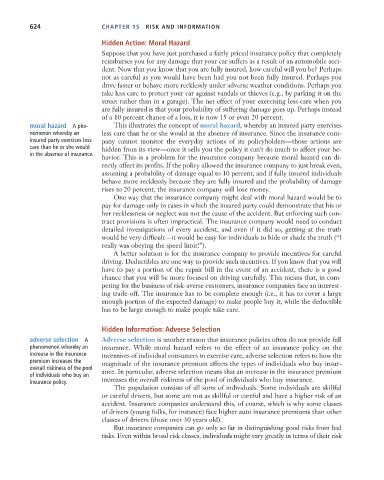Page 650 - Microeconomics, Fourth Edition
P. 650
c15riskandinformation.qxd 8/16/10 11:10 AM Page 624
624 CHAPTER 15 RISK AND INFORMATION
Hidden Action: Moral Hazard
Suppose that you have just purchased a fairly priced insurance policy that completely
reimburses you for any damage that your car suffers as a result of an automobile acci-
dent. Now that you know that you are fully insured, how careful will you be? Perhaps
not as careful as you would have been had you not been fully insured. Perhaps you
drive faster or behave more recklessly under adverse weather conditions. Perhaps you
take less care to protect your car against vandals or thieves (e.g., by parking it on the
street rather than in a garage). The net effect of your exercising less care when you
are fully insured is that your probability of suffering damage goes up. Perhaps instead
of a 10 percent chance of a loss, it is now 15 or even 20 percent.
moral hazard A phe- This illustrates the concept of moral hazard, whereby an insured party exercises
nomenon whereby an less care than he or she would in the absence of insurance. Since the insurance com-
insured party exercises less pany cannot monitor the everyday actions of its policyholders—those actions are
care than he or she would hidden from its view—once it sells you the policy it can’t do much to affect your be-
in the absence of insurance.
havior. This is a problem for the insurance company because moral hazard can di-
rectly affect its profits. If the policy allowed the insurance company to just break even,
assuming a probability of damage equal to 10 percent, and if fully insured individuals
behave more recklessly because they are fully insured and the probability of damage
rises to 20 percent, the insurance company will lose money.
One way that the insurance company might deal with moral hazard would be to
pay for damage only in cases in which the insured party could demonstrate that his or
her recklessness or neglect was not the cause of the accident. But enforcing such con-
tract provisions is often impractical. The insurance company would need to conduct
detailed investigations of every accident, and even if it did so, getting at the truth
would be very difficult—it would be easy for individuals to hide or shade the truth (“I
really was obeying the speed limit!”).
A better solution is for the insurance company to provide incentives for careful
driving. Deductibles are one way to provide such incentives. If you know that you will
have to pay a portion of the repair bill in the event of an accident, there is a good
chance that you will be more focused on driving carefully. This means that, in com-
peting for the business of risk-averse customers, insurance companies face an interest-
ing trade-off. The insurance has to be complete enough (i.e., it has to cover a large
enough portion of the expected damage) to make people buy it, while the deductible
has to be large enough to make people take care.
Hidden Information: Adverse Selection
adverse selection A Adverse selection is another reason that insurance policies often do not provide full
phenomenon whereby an insurance. While moral hazard refers to the effect of an insurance policy on the
increase in the insurance incentives of individual consumers to exercise care, adverse selection refers to how the
premium increases the magnitude of the insurance premium affects the types of individuals who buy insur-
overall riskiness of the pool ance. In particular, adverse selection means that an increase in the insurance premium
of individuals who buy an
insurance policy. increases the overall riskiness of the pool of individuals who buy insurance.
The population consists of all sorts of individuals. Some individuals are skillful
or careful drivers, but some are not as skillful or careful and have a higher risk of an
accident. Insurance companies understand this, of course, which is why some classes
of drivers (young folks, for instance) face higher auto insurance premiums than other
classes of drivers (those over 30 years old).
But insurance companies can go only so far in distinguishing good risks from bad
risks. Even within broad risk classes, individuals might vary greatly in terms of their risk

